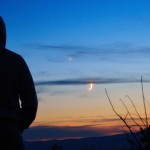

Use the moon to find the planets Mars and Saturn, and the star Antares in late February and early March. Read more.
March 2016 is the best month of this year for seeing the planet Jupiter. The Earth in its faster, smaller orbit around the sun swings in between the sun and Jupiter on March 8, 2016. This marks Jupiter’s opposition, when it appears opposite the sun in Earth’s sky.
The king planet Jupiter lords over the nighttime sky whenever it’s at opposition. Jupiter not only shines all night long, but beams at its brightest best for the year. At opposition, this dazzling world rises in the east at sunset, climbs highest up for the night at midnight and sets in the west at sunrise. Although Jupiter ranks as the second-brightest planet, after Venus, Venus is only visible for a short while before sunrise. That leaves the king planet to rule the night.
Two other planets, Mars and Saturn, are in fine view in the morning sky. If you’re a morning person, you’re in luck because Mars and Saturn are best seen in the predawn sky, especially during the dark hour before dawn. Follow the links below to learn more about the March planets.
Mercury lost in glare of sunrise
Venus, brightest planet, east before sunrise
Jupiter lords over the March nighttime sky
Mars, brightening daily, from late night till dawn
Saturn, near Antares, shines in predawn sky
Like what EarthSky offers? Sign up for our free daily newsletter today!
Astronomy events, star parties, festivals, workshops
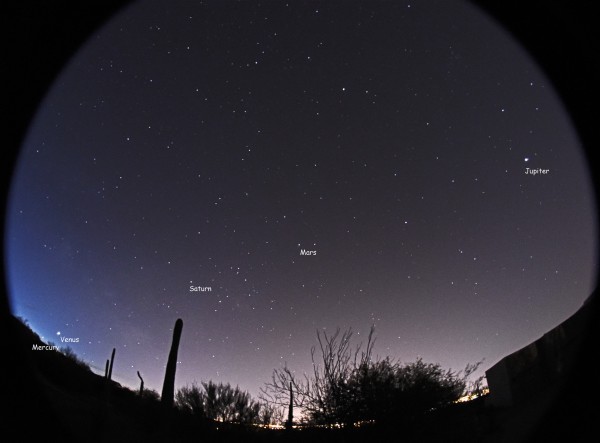
From late January, and through mid-February, 5 bright planets were visible at once in the predawn sky. This image is from February 8, 2016. It’s by Eliot Herman in Tucson, Arizona. View on Flickr.
Mercury lost in the glare of sunrise. In the final week of January 2016 and the first two weeks of February 2016, Mercury joined up with the other four morning planets – Venus, Saturn, Mars and Jupiter – to present all five naked-eye planets in the same sky for the first time since the year 2005. Numerous EarthSky stargazers around the globe shared their photos of the five planets for our viewing pleasure. We extend a great big thank you to our EarthSky friends!
Photos of all five naked-eye planets in one sky
See all five visible planets simultaneously!
Mercury rises before the sun in early March but probably sits too close to close to the glare of sunrise to be visible. Mercury swings behind the sun on March 23, to transition from the morning to the evening sky. Quite by coincidence, the March 2016 full moon falls on this same date, on March 23.
First of season’s 4 full moons March 23
Don’t expect to see Mercury in March 2016. Some two weeks after Mercury’s entry into the evening sky in late March, look for the solar system’s innermost planet to become visible after sunset toward the end of the first week of April. For the Northern Hemisphere, this will be Mercury’s finest apparition in the evening sky for the year. Stayed tuned!

Beth Katz wrote on February 12: “Finally caught Mercury and Venus from Lancaster County, Pennsylvania on Friday, February 12, 2016. The snow in my yard has kept me from wandering around with the tripod to find the right place to avoid the trees.”
Venus, brightest planet, east before sunrise. No matter where you are on Earth, here’s a very fun observation to make this month: Venus at dawn. Venus is the brightest planet and third-brightest sky object overall, after the sun and moon. When it’s visible, it’s very, very prominent in our sky.
But this month, in March 2016, you’ll have to be especially vigilant to catch Venus before sunrise – especially from northerly latitudes in the Northern Hemisphere. From both the Northern and Southern Hemispheres, Venus will be sinking toward the sunrise throughout the month.
As viewed from mid-northern latitudes, Venus starts the month rising about one hour before the sun, yet by the month’s end, only rises about one-half hour before sunrise. The view is better from the Southern Hemisphere, with Venus rising about two hours before the sun in early March, and about one and one-hours hours before sunrise by the month’s end.
Look for the thin waning crescent moon to pair up with Venus in your eastern sky before sunrise March 7. Binoculars may come in handy if you live in the Northern Hemisphere.

Moon closest to Jupiter on March 21. Read more
Jupiter lords over the March nighttime sky. Jupiter is the only planet to light up the sky almost immediately after sunset, blazing away in the east at nightfall or early evening in early March. Jupiter reaches opposition on March 8, at which time this brilliant world rises in the east at sunset, climbs highest up for the night at midnight and sets in the west at sunrise. Jupiter’s opposition is an especially celebrated event, because that’s when this world is out all night long, from dusk till dawn. Moreover, this is when Earth comes closest to Jupiter for the year, and Jupiter, in turn, shines at its brightest best in Earth’s sky.
Jupiter’s opposition happens less than one day before the new moon, providing a deliciouslydark sky for observing Jupiter through the telescope. By the way, the new moon on March 8-9 will pass in front of the sun, to stage a total solar eclipse in Indonesia, and a partial solar eclipse for much of southern and eastern Asia, northern and western Australia, Alaska and Hawaii.
Supermoon total solar eclipse March 8-9
The moon swings close to Jupiter on the sky’s dome for several days, centered on March 21.
If you have binoculars or a telescope, it’s fairly easy to see Jupiter’s four major moons, which look like pinpricks of light on or near the same plane. They are often called the Galilean moons to honor Galileo, who discovered these great Jovian moons in 1610. In their order from Jupiter, these moons are Io, Europa, Ganymede and Callisto.
These moons circle Jupiter around the Jovian equator. In cycles of six years, we view Jupiter’s equator edge-on. So, in 2015, we got to view a number of mutual events involving Jupiter’s moons through a high-powered telescope. Click here or here or here for more details.
Although Jupiter’s axial tilt is only 3o out of perpendicular relative to the ecliptic (Earth’s orbital plane), Jupiter’s axis will tilt enough toward the sun and Earth so that the farthest of these four moons, Callisto, will NOT pass in front of Jupiter or behind Jupiter for a period of about three years, starting in late 2016. During this approximate 3-year period, Callisto will remain “perpetually” visible, alternately swinging “above” and “below” Jupiter.
Click here for a Jupiter’s moons almanac, courtesy of Sky & Telescope.

Watch the moon move past the planets Mars and Saturn, plus the star Antares in late March. The green line depicts the ecliptic – Earth’s orbital plane projected onto the constellations of the Zodiac.
Mars, brightening daily, from late night till dawn. Mars is not as bright as Venus or Jupiter. However, Mars will be brightening by leaps and bounds in the next several months, to double in brilliance in March 2016 alone. Mars rises in the east quite late at night from mid-northern latitudes all month long. Mars rises around midnight local time in early March, and around 11:00 p.m. local time (midnight by daylight-saving time) by the month’s end.
Mars rises earlier at temperate latitudes in the Southern Hemisphere. In early March, the red planet comes up around 10 to 11 p.m. local time in early March, and by the month’s end, at roughly 9 p.m. local time.
Let the waning crescent moon help guide your eye to Mars (and Saturn) in the morning sky on March 1. Then, to double your pleasure, watch the moon swing by Mars (and Saturn) at the month’s end, too, as shown on the above sky chart. Mars will eventually catch up with Saturn on August 25, 2016, to present a conjunction of these two worlds in the August evening sky.
From either the Northern or Southern Hemisphere, Mars (and nearby Saturn) are best viewed in the morning hours. Look for Mars and Saturn to be highest up in the sky just before dawn’s first light.
Mars will continue to brighten month by month, until the Red Planet culminates in brightness in May, 2016. Believe it or not, Mars will be about as brilliant then as Jupiter is now!

We’re looking ahead to some three months later, when Jupiter, Mars and Saturn will be lighting up the June 2016 evening sky as soon as darkness falls. The green line depicts the ecliptic – the sun’s yearly path in front of the constellations of the Zodiac.
Saturn, near Antares, shines in predawn sky. Saturn shines near Antares, the brightest star in the constellation Scorpius all through March 2016. From mid-northern latitudes, the ringed planet starts the month rising in the east around 2 a.m. local time. By the month’s end, Saturn rises at about midnight local time (1 a.m. local daylight-saving time).
As for temperate latitudes in the Southern Hemisphere, Saturn rises in the east at roughly midnight local time in early March. By the end of the month, Saturn will be up around 10 p.m. local time.
Although Saturn shines on par with the sky’s brightest stars, its brilliance can’t match that of Mars. Look for Saturn near Mars in the predawn sky, and for these two worlds to form a bright celestial triangle with the star Antares in the March predawn sky. Mars is brighter than Saturn, which in turn is brighter than Antares.
Watch for the moon to swing by Saturn for several days, centered on or near March 29. See the above sky chart.
Saturn, the farthest world that you can easily view with the eye alone, appears golden in color. It shines with a steady light. Binoculars don’t reveal Saturn’s gorgeous rings, by the way. For that, you need a small telescope. But binoculars will enhance Saturn’s golden color.
Saturn’s rings are inclined at a little more than 26o from edge-on in March 2016, exhibiting their northern face. Next year, in October 2017, the rings will open most widely, displaying a maximum inclination of 27o. As with so much in space (and on Earth), the appearance of Saturn’s rings from Earth is cyclical. In the year 2025, the rings will appear edge-on as seen from Earth. After that, we’ll begin to see the south side of Saturn’s rings, to increase to a maximum inclination of 27o by May, 2032.
Click here for recommended almanacs. They can help you know when the planets rise, transit and set in your sky
What do we mean by visible planet? By visible planet, we mean any solar system planet that is easily visible without an optical aid and that has been watched by our ancestors since time immemorial. In their outward order from the sun, the five visible planets are Mercury, Venus, Mars, Jupiter and Saturn. These planets are visible in our sky because their disks reflect sunlight, and these relatively nearby worlds tend to shine with a steadier light than the distant, twinkling stars. They’re often bright! You can spot them, and come to know them as faithful friends, if you try.
Bottom line: March 2016 is Jupiter’s month to bask in the light of the sun. But two other planets, Mars and Saturn, are in fine view in the predawn hours, and with some diligence, you might catch Venus before sunrise.
Easily locate stars and constellations with EarthSky’s planisphere.
Don’t miss anything. Subscribe to EarthSky News by email
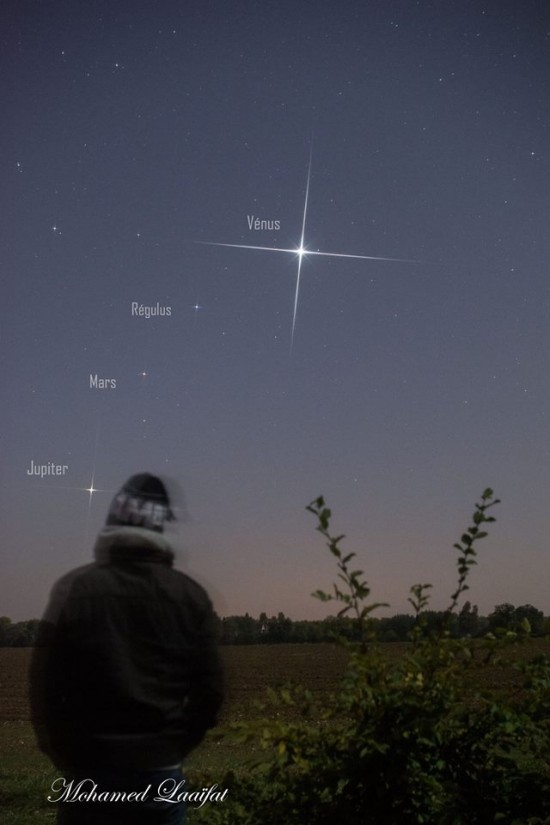
Awesome month for planets before dawn: October, 2015! Photo taken October 2, 2015 by Mohamed Laaifat Photographies in Normandy, France.
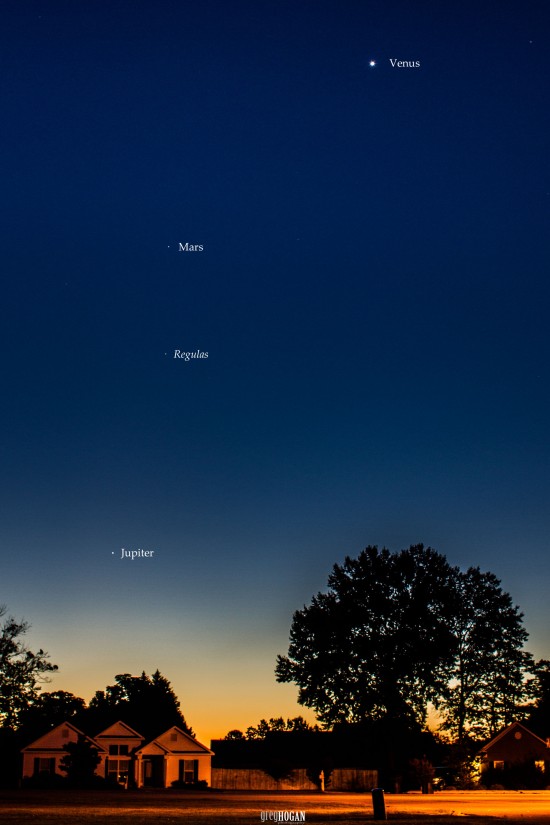
Eastern sky before dawn now. Photo taken September 18, 2015 and submitted to EarthSky by Greg Hogan in Kathleen, Georgia. Thanks, Greg!

View larger. Evening dusk on August 5: Venus at left. Mercury is climbing higher, toward Regulus (at top) and Jupiter (beneath Regulus).

By the evening of July 12, Venus and Jupiter were farther apart and lower in the western sky after sunset. Photo by Robert Kelly. Thanks, Robert!
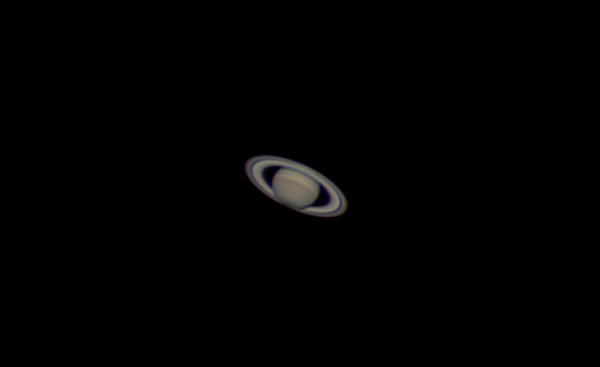
Photo taken June 13, 2015 by John Nelson at Puget Sound, Washington. Thanks, John!
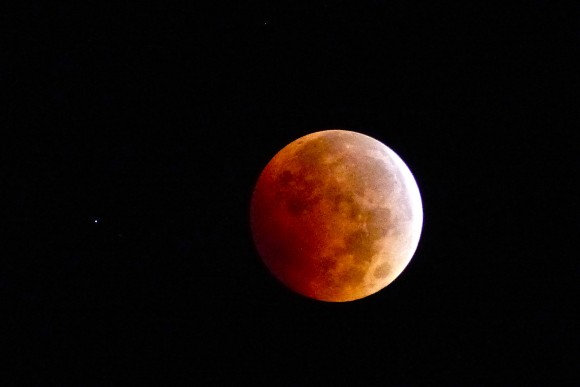
Lunar eclipse on the night of October 8, 2014. The object to the left is the planet Uranus! This beautiful photo is by Janey Wing Kenyon of Story, Wyoming.

Debra Fryar in Calobreves, Texas captured this photo of the moon and Jupiter on May 31, 2014. Jupiter was close to the twilight then.
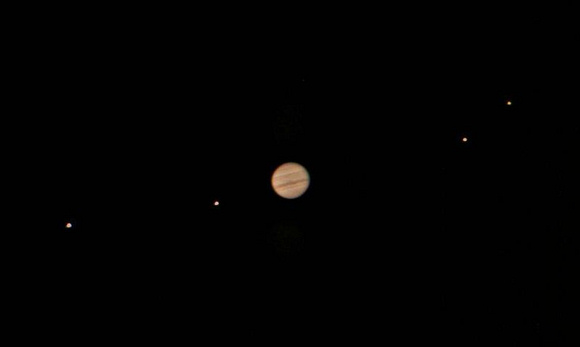
With only a modest backyard telescope, you can easily see Jupiter’s four largest moons. Here they are through a 10″ (25 cm) Meade LX200 telescope. Image credit: Jan Sandberg
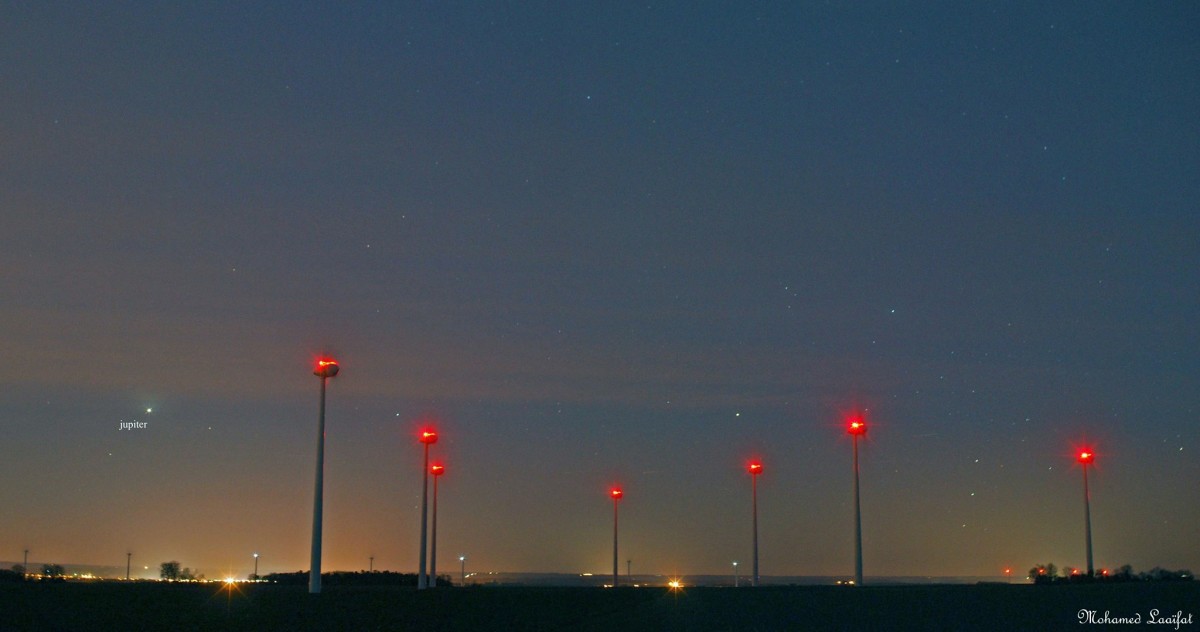
Jupiter was rivaling the streetlights, when Mohamed Laaifat Photographies captured this photo in Normandy, France. Visit his page on Facebook.

Venus by Danny Crocker-Jensen
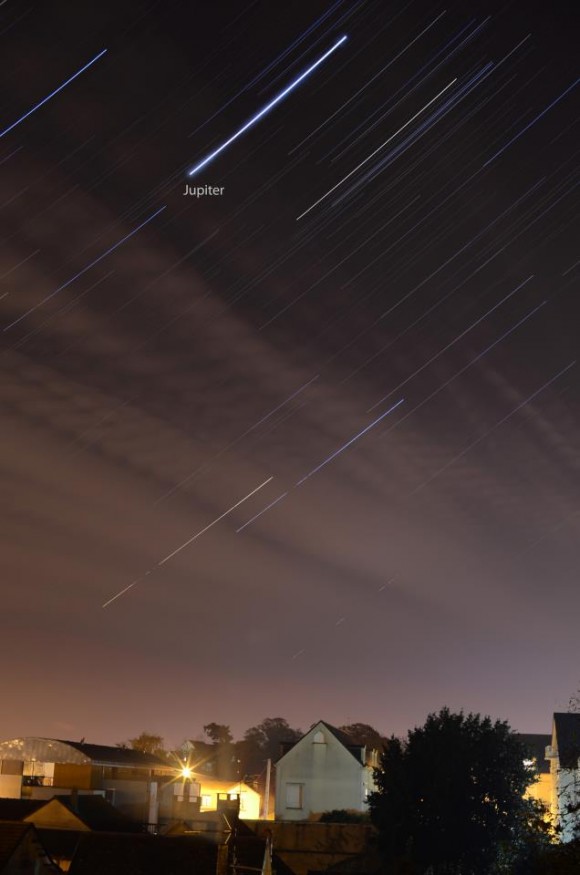
These are called star trails. It’s a long-exposure photo, which shows you how Earth is turning under the stars. The brightest object here is Jupiter, which is the second-brightest planet, after Venus. This awesome photo by EarthSky Facebook friend Mohamed Laaifat in Normandy, France. Thank you, Mohamed.

Skywatcher, by Predrag Agatonovic.
Easily locate stars and constellations with EarthSky’s planisphere.
Don’t miss anything. Subscribe to EarthSky News by email
from EarthSky http://ift.tt/IJfHCr


Use the moon to find the planets Mars and Saturn, and the star Antares in late February and early March. Read more.
March 2016 is the best month of this year for seeing the planet Jupiter. The Earth in its faster, smaller orbit around the sun swings in between the sun and Jupiter on March 8, 2016. This marks Jupiter’s opposition, when it appears opposite the sun in Earth’s sky.
The king planet Jupiter lords over the nighttime sky whenever it’s at opposition. Jupiter not only shines all night long, but beams at its brightest best for the year. At opposition, this dazzling world rises in the east at sunset, climbs highest up for the night at midnight and sets in the west at sunrise. Although Jupiter ranks as the second-brightest planet, after Venus, Venus is only visible for a short while before sunrise. That leaves the king planet to rule the night.
Two other planets, Mars and Saturn, are in fine view in the morning sky. If you’re a morning person, you’re in luck because Mars and Saturn are best seen in the predawn sky, especially during the dark hour before dawn. Follow the links below to learn more about the March planets.
Mercury lost in glare of sunrise
Venus, brightest planet, east before sunrise
Jupiter lords over the March nighttime sky
Mars, brightening daily, from late night till dawn
Saturn, near Antares, shines in predawn sky
Like what EarthSky offers? Sign up for our free daily newsletter today!
Astronomy events, star parties, festivals, workshops

From late January, and through mid-February, 5 bright planets were visible at once in the predawn sky. This image is from February 8, 2016. It’s by Eliot Herman in Tucson, Arizona. View on Flickr.
Mercury lost in the glare of sunrise. In the final week of January 2016 and the first two weeks of February 2016, Mercury joined up with the other four morning planets – Venus, Saturn, Mars and Jupiter – to present all five naked-eye planets in the same sky for the first time since the year 2005. Numerous EarthSky stargazers around the globe shared their photos of the five planets for our viewing pleasure. We extend a great big thank you to our EarthSky friends!
Photos of all five naked-eye planets in one sky
See all five visible planets simultaneously!
Mercury rises before the sun in early March but probably sits too close to close to the glare of sunrise to be visible. Mercury swings behind the sun on March 23, to transition from the morning to the evening sky. Quite by coincidence, the March 2016 full moon falls on this same date, on March 23.
First of season’s 4 full moons March 23
Don’t expect to see Mercury in March 2016. Some two weeks after Mercury’s entry into the evening sky in late March, look for the solar system’s innermost planet to become visible after sunset toward the end of the first week of April. For the Northern Hemisphere, this will be Mercury’s finest apparition in the evening sky for the year. Stayed tuned!

Beth Katz wrote on February 12: “Finally caught Mercury and Venus from Lancaster County, Pennsylvania on Friday, February 12, 2016. The snow in my yard has kept me from wandering around with the tripod to find the right place to avoid the trees.”
Venus, brightest planet, east before sunrise. No matter where you are on Earth, here’s a very fun observation to make this month: Venus at dawn. Venus is the brightest planet and third-brightest sky object overall, after the sun and moon. When it’s visible, it’s very, very prominent in our sky.
But this month, in March 2016, you’ll have to be especially vigilant to catch Venus before sunrise – especially from northerly latitudes in the Northern Hemisphere. From both the Northern and Southern Hemispheres, Venus will be sinking toward the sunrise throughout the month.
As viewed from mid-northern latitudes, Venus starts the month rising about one hour before the sun, yet by the month’s end, only rises about one-half hour before sunrise. The view is better from the Southern Hemisphere, with Venus rising about two hours before the sun in early March, and about one and one-hours hours before sunrise by the month’s end.
Look for the thin waning crescent moon to pair up with Venus in your eastern sky before sunrise March 7. Binoculars may come in handy if you live in the Northern Hemisphere.

Moon closest to Jupiter on March 21. Read more
Jupiter lords over the March nighttime sky. Jupiter is the only planet to light up the sky almost immediately after sunset, blazing away in the east at nightfall or early evening in early March. Jupiter reaches opposition on March 8, at which time this brilliant world rises in the east at sunset, climbs highest up for the night at midnight and sets in the west at sunrise. Jupiter’s opposition is an especially celebrated event, because that’s when this world is out all night long, from dusk till dawn. Moreover, this is when Earth comes closest to Jupiter for the year, and Jupiter, in turn, shines at its brightest best in Earth’s sky.
Jupiter’s opposition happens less than one day before the new moon, providing a deliciouslydark sky for observing Jupiter through the telescope. By the way, the new moon on March 8-9 will pass in front of the sun, to stage a total solar eclipse in Indonesia, and a partial solar eclipse for much of southern and eastern Asia, northern and western Australia, Alaska and Hawaii.
Supermoon total solar eclipse March 8-9
The moon swings close to Jupiter on the sky’s dome for several days, centered on March 21.
If you have binoculars or a telescope, it’s fairly easy to see Jupiter’s four major moons, which look like pinpricks of light on or near the same plane. They are often called the Galilean moons to honor Galileo, who discovered these great Jovian moons in 1610. In their order from Jupiter, these moons are Io, Europa, Ganymede and Callisto.
These moons circle Jupiter around the Jovian equator. In cycles of six years, we view Jupiter’s equator edge-on. So, in 2015, we got to view a number of mutual events involving Jupiter’s moons through a high-powered telescope. Click here or here or here for more details.
Although Jupiter’s axial tilt is only 3o out of perpendicular relative to the ecliptic (Earth’s orbital plane), Jupiter’s axis will tilt enough toward the sun and Earth so that the farthest of these four moons, Callisto, will NOT pass in front of Jupiter or behind Jupiter for a period of about three years, starting in late 2016. During this approximate 3-year period, Callisto will remain “perpetually” visible, alternately swinging “above” and “below” Jupiter.
Click here for a Jupiter’s moons almanac, courtesy of Sky & Telescope.

Watch the moon move past the planets Mars and Saturn, plus the star Antares in late March. The green line depicts the ecliptic – Earth’s orbital plane projected onto the constellations of the Zodiac.
Mars, brightening daily, from late night till dawn. Mars is not as bright as Venus or Jupiter. However, Mars will be brightening by leaps and bounds in the next several months, to double in brilliance in March 2016 alone. Mars rises in the east quite late at night from mid-northern latitudes all month long. Mars rises around midnight local time in early March, and around 11:00 p.m. local time (midnight by daylight-saving time) by the month’s end.
Mars rises earlier at temperate latitudes in the Southern Hemisphere. In early March, the red planet comes up around 10 to 11 p.m. local time in early March, and by the month’s end, at roughly 9 p.m. local time.
Let the waning crescent moon help guide your eye to Mars (and Saturn) in the morning sky on March 1. Then, to double your pleasure, watch the moon swing by Mars (and Saturn) at the month’s end, too, as shown on the above sky chart. Mars will eventually catch up with Saturn on August 25, 2016, to present a conjunction of these two worlds in the August evening sky.
From either the Northern or Southern Hemisphere, Mars (and nearby Saturn) are best viewed in the morning hours. Look for Mars and Saturn to be highest up in the sky just before dawn’s first light.
Mars will continue to brighten month by month, until the Red Planet culminates in brightness in May, 2016. Believe it or not, Mars will be about as brilliant then as Jupiter is now!

We’re looking ahead to some three months later, when Jupiter, Mars and Saturn will be lighting up the June 2016 evening sky as soon as darkness falls. The green line depicts the ecliptic – the sun’s yearly path in front of the constellations of the Zodiac.
Saturn, near Antares, shines in predawn sky. Saturn shines near Antares, the brightest star in the constellation Scorpius all through March 2016. From mid-northern latitudes, the ringed planet starts the month rising in the east around 2 a.m. local time. By the month’s end, Saturn rises at about midnight local time (1 a.m. local daylight-saving time).
As for temperate latitudes in the Southern Hemisphere, Saturn rises in the east at roughly midnight local time in early March. By the end of the month, Saturn will be up around 10 p.m. local time.
Although Saturn shines on par with the sky’s brightest stars, its brilliance can’t match that of Mars. Look for Saturn near Mars in the predawn sky, and for these two worlds to form a bright celestial triangle with the star Antares in the March predawn sky. Mars is brighter than Saturn, which in turn is brighter than Antares.
Watch for the moon to swing by Saturn for several days, centered on or near March 29. See the above sky chart.
Saturn, the farthest world that you can easily view with the eye alone, appears golden in color. It shines with a steady light. Binoculars don’t reveal Saturn’s gorgeous rings, by the way. For that, you need a small telescope. But binoculars will enhance Saturn’s golden color.
Saturn’s rings are inclined at a little more than 26o from edge-on in March 2016, exhibiting their northern face. Next year, in October 2017, the rings will open most widely, displaying a maximum inclination of 27o. As with so much in space (and on Earth), the appearance of Saturn’s rings from Earth is cyclical. In the year 2025, the rings will appear edge-on as seen from Earth. After that, we’ll begin to see the south side of Saturn’s rings, to increase to a maximum inclination of 27o by May, 2032.
Click here for recommended almanacs. They can help you know when the planets rise, transit and set in your sky
What do we mean by visible planet? By visible planet, we mean any solar system planet that is easily visible without an optical aid and that has been watched by our ancestors since time immemorial. In their outward order from the sun, the five visible planets are Mercury, Venus, Mars, Jupiter and Saturn. These planets are visible in our sky because their disks reflect sunlight, and these relatively nearby worlds tend to shine with a steadier light than the distant, twinkling stars. They’re often bright! You can spot them, and come to know them as faithful friends, if you try.
Bottom line: March 2016 is Jupiter’s month to bask in the light of the sun. But two other planets, Mars and Saturn, are in fine view in the predawn hours, and with some diligence, you might catch Venus before sunrise.
Easily locate stars and constellations with EarthSky’s planisphere.
Don’t miss anything. Subscribe to EarthSky News by email

Awesome month for planets before dawn: October, 2015! Photo taken October 2, 2015 by Mohamed Laaifat Photographies in Normandy, France.

Eastern sky before dawn now. Photo taken September 18, 2015 and submitted to EarthSky by Greg Hogan in Kathleen, Georgia. Thanks, Greg!

View larger. Evening dusk on August 5: Venus at left. Mercury is climbing higher, toward Regulus (at top) and Jupiter (beneath Regulus).

By the evening of July 12, Venus and Jupiter were farther apart and lower in the western sky after sunset. Photo by Robert Kelly. Thanks, Robert!

Photo taken June 13, 2015 by John Nelson at Puget Sound, Washington. Thanks, John!

Lunar eclipse on the night of October 8, 2014. The object to the left is the planet Uranus! This beautiful photo is by Janey Wing Kenyon of Story, Wyoming.

Debra Fryar in Calobreves, Texas captured this photo of the moon and Jupiter on May 31, 2014. Jupiter was close to the twilight then.

With only a modest backyard telescope, you can easily see Jupiter’s four largest moons. Here they are through a 10″ (25 cm) Meade LX200 telescope. Image credit: Jan Sandberg

Jupiter was rivaling the streetlights, when Mohamed Laaifat Photographies captured this photo in Normandy, France. Visit his page on Facebook.

Venus by Danny Crocker-Jensen

These are called star trails. It’s a long-exposure photo, which shows you how Earth is turning under the stars. The brightest object here is Jupiter, which is the second-brightest planet, after Venus. This awesome photo by EarthSky Facebook friend Mohamed Laaifat in Normandy, France. Thank you, Mohamed.

Skywatcher, by Predrag Agatonovic.
Easily locate stars and constellations with EarthSky’s planisphere.
Don’t miss anything. Subscribe to EarthSky News by email
from EarthSky http://ift.tt/IJfHCr


